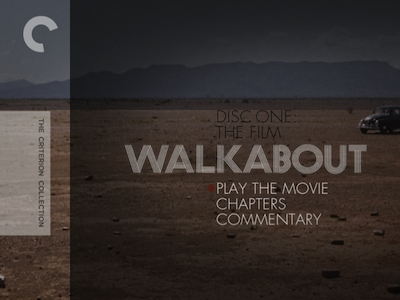
Nicolas Roeg's 1971 film Walkabout is a highly regarded required taste. A slab of surreal young adult fiction, it is the story of two cultures coming together under strange and extraordinary circumstances.
Roeg sets up his divide from the get-go. Set in Australia, the first scenes juxtapose the hustle and bustle of modern city life with the traditional native sounds of the country; namely, didgeridoo music plays over the top of scenes of traffic jams, marching soldiers, and schoolgirls engaging in vaguely erotic breathing exercises. We see our central characters within the montage. The girl (as she is called, and as played by Jenny Agutter) is amongst the girls getting voice lessons, and her little brother (Lucien John, a.k.a. Luc Roeg) is seen out in the streets, watching the parade. He walks through a park where the trees are as regimented and labeled as any other aspect of city living. Here, butcher shops sell kangaroo meat. Roeg is showing us how the more exotic aspects of the continent are being commodified.
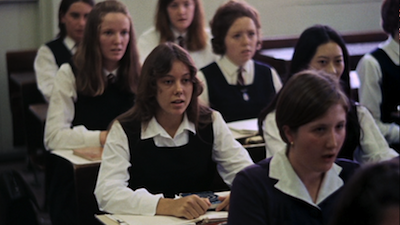
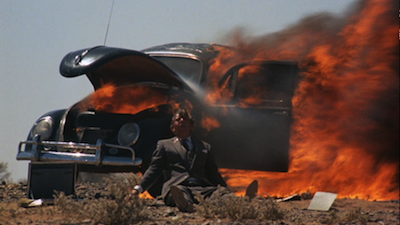
This, we can interpret, is the modern disease, and the end-stage of said disease is what is about to affect the brother and sister. Their father is a geologist of some kind, a man whose job is to dig into the earth and extract its guts. He drives his children out into the middle of the desert and then proceeds to set the car on fire and shoot himself in the head. Determined to keep her little brother from seeing this, the girl leads him away from the car and deep into the outback. They wander for a couple of days, barely surviving, before they meet an aboriginal boy (David Gulpilil). He is on "walkabout," a rite of passage where young men leave their tribes and survive on their skill and wits. He doesn't speak English, but certain fundamental rules of communication, when applied, hip him to the plight of these two strange children (both in their school uniforms). The boy knows where they need to go and how to stay alive getting there, and he begins to lead the white children back toward their version of civilization.

Walkabout is written by Edward Bond (one of the writers on Antonioni's Blow-Up
To me, these scenes are unwelcome interruptions, and their execution too bald to be effective. Roeg hammers all of his political messages pretty hard. There are, for instance, the shots of Gulpilil on the hunt cut together with a butcher slicing up slabs of meat, which are supposed to challenge our perceptions of hunting and cause us to think about where our food comes from. The boy kills to survive, it's no more brutal than what goes on every day in the city. Further on, we see him wrestle an animal with his bare hands, and it's almost playful. Moments later, white hunters come in and slaughter a herd with their rifles. They never even leave their jeep. Roeg, who acted as his own cinematographer, photographs the killing with the rawness of Vietnam news footage. On paper, it sounds good, but in practice, it seems all too easy. Perhaps it was effective and shocking forty years ago, but now it just comes off as clumsy.

Some of the heavy symbolism is forgivable, though, as it does seem like the core of Walkabout is aimed at a younger audience. Thus, seeing the young white boy playing at war games, shooting a pistol and mimicking the sounds of his miniature biplane, makes for an acceptable symbol of British aggression--especially as, at that same time, his sister is setting up a picnic and listening to an etiquette lesson. He is the more brutal aspects of colonialism, she is the imposition of "polite society." Later, when the siblings find a desert oasis, it transforms overnight into a forbidding dry patch full of snakes and insects. They are the chosen ones being cast from the Garden of Eden. (Perhaps the weirdest moment of the movie is when the little boy is seen in extreme close-up biting into a piece of fruit and declaring it tastes like meat.) It's not subtle, but it gets the point across without being insulting.
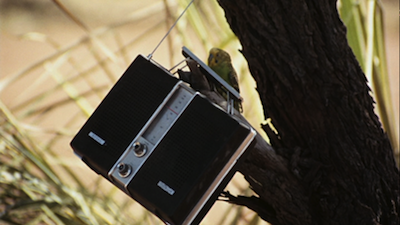
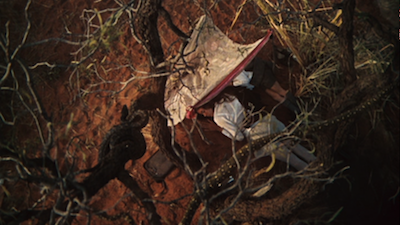
I think the main reason I object to the asides to the "adult world" so much is that the contained dreamscape of the three youths is so effective. Roeg and Bond construct their joint walkabout as a kind of magical journey. They aren't restrained by time. In one scene, they are dressed in normal clothes; in the next, they are stripped down and wearing detailed tribal make-up. These leaps add to the fantastical quality that blurs the edges of their reality. They find some common ground despite the barriers between them, and the visual language changes. Early on in the journey, the girl walks under a make-shift canopy, looking very much like a white tourist being led by her black servant. He is an "other" at that point, almost silly for not understanding their way of doing things; eventually, though, they begin to adopt his way of doing things. Admittedly, this could still be seen as cultural tourism, and I am not sure I am comfortable with Roeg visually contrasting Jenny Agutter swimming naked with images of nude aborigines beating on her father's burnt-out car. There are visual parallels here to scenes from other movies where less-evolved primates are freaked out by technology. This sequence even ends with the group leaving the car when the radio comes alive and scares them.
There is something exploitative about the way Roeg films Agutter. Even before we see her naked, she is shown in various states of undress and there are regular shots of her underwear, both on and off. She is presented in a sexualized manner throughout Walkabout, and though the actress was 18 or 19, the schoolgirl she plays is much younger. The story is intended to be an awakening for the girl, and one could interpret that there are unfortunate racial implications to the sexual aspects of it. It's as if Roeg keeps offering her up as forbidden fruit, the white woman serving as temptation for the black man. He doesn't really address the volatile politics connected to that, nor does the movie take any time with the cliché of its final scenes: that having experienced life with the black man, the white girl is now forever changed, forever dreaming of returning to the "wild."
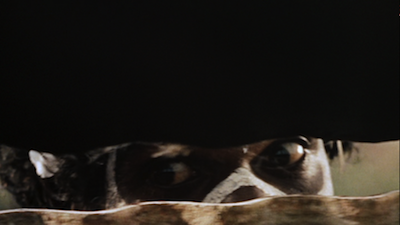
I don't really think that Roeg is trying to play to those dangerous stereotypes so much as he is playing with them. Regardless, he must have been aware that they were there. Again, I would say he's dealing more with culture than race, and I certainly don't think he was being racist, he was instead using these things to challenge the status quo. Near the end of the journey, the trio find an abandoned home just on the edge of white civilization, and the girl starts to set up house. She is creating a domestic situation with her as the mother, the aborigine as the father, and her brother as the child. This, of course, isn't going to work. This is where the white hunters come in, and when Gulpilil returns to the house, outfitted in traditional tribal make-up and engaging in what I assume is a courtship dance, his reversion to his own cultural standards frightens the girl. She wanted him to move closer to her, effectively obliterating the middle ground, and as a result, forcing them both to retreat to what they are used to.

This is some pretty serious stuff, and that is why it's all the more frustrating that Walkabout has so much extraneous nonsense. The sidebars are all satirical jabs at white society, yet they take away from time that could be spent on the central relationships of the movie. Also, if you're going to isolate these characters and send them on a mythic journey, I just don't see the sense in breaking the spell. That should come at the end, when the kids get home, returning to bad manners and noisy congestion. The balloon would have only burst the once rather than slowly leaking throughout.
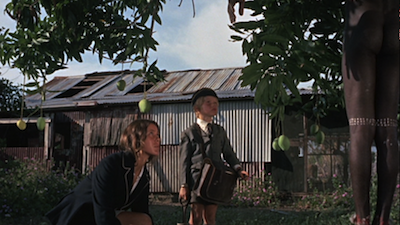
The new two-disc release of Walkabout is a much needed updating of one of the earliest Criterions. Now available as both a standard-definition release
The only extra feature on the original disc was an audio commentary with Roeg and Jenny Agutter, and that is also available on this set. The second disc now also contains interviews with Agutter and Luc Roeg, as well as a full-length documentary about David Gulpilil, an important figure in Australian cinema. His work as an authentic Aboriginal actor was as important politically as it was artistically. (Criterion fans may also remember him from Peter Weir's The Last Wave.) One change of note to long-term collectors: the essay by Roger Ebert from the 1998 disc has been replaced by a piece from author Paul Ryan.

Watch the theatrical trailer.
This disc was provided by the Criterion Collection for purposes of review.

2 comments:
You really don't know what you're talking about. This was a mesmerizing film, with all the shots relevant to the theme and plot. Also, Jenny Agutter was 16 during the shooting of it, not 17 or 18. Nothing is 'exploitative', since it is demonstrating the devastating sexual attractiveness of her which literally kills the Aboriginal boy.
This has to be the shittiest and most inaccurate review I've ever seen written. Were we even watching the same movie? Every single sentence you wrote missed the mark by miles.
Post a Comment